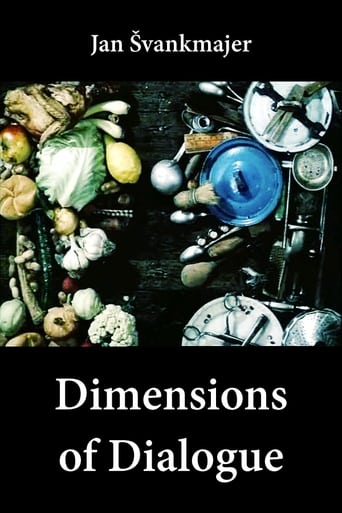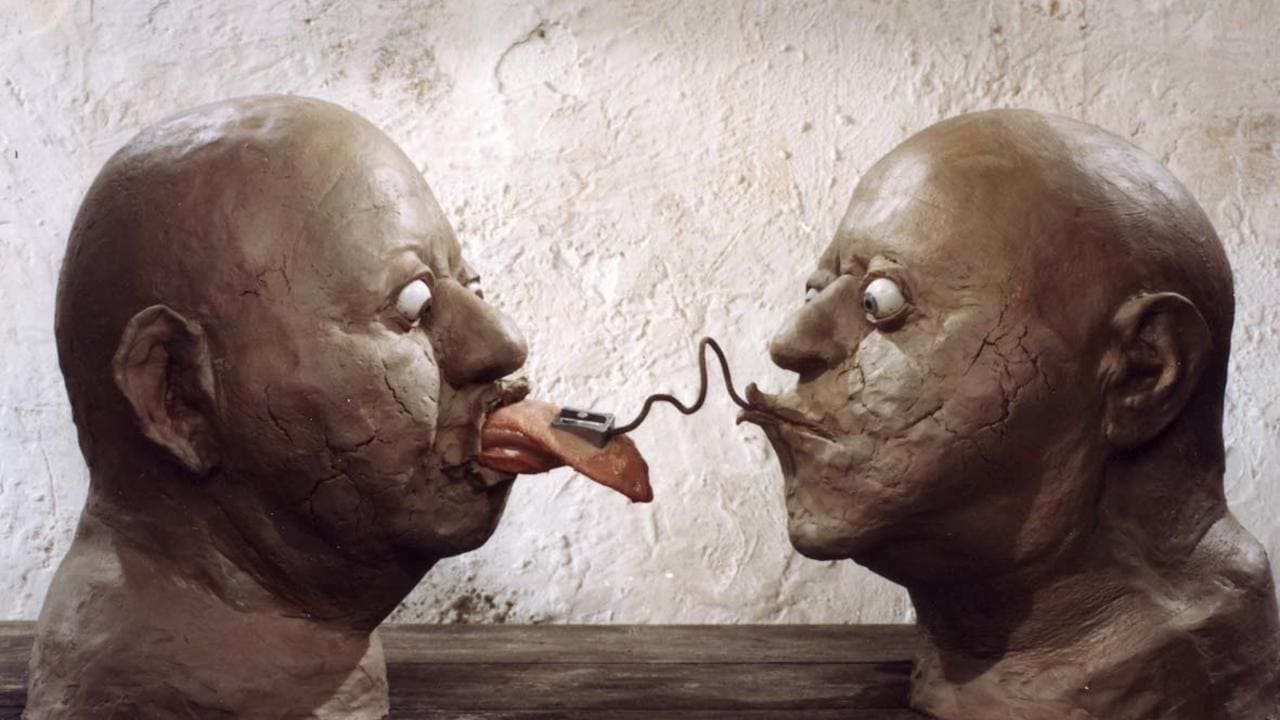TheEllipsesPrintingGin
Moznosti Dialogu can be translated as Dimensions of Dialogue or Possibilities of Dialogue. In either translation the idea that there is a depth of interpretation within the exchanging of ideas remains. The three "act" film by the casual and uninterested eye is assumed to be beyond reason and seen as merely a smörgåsbord of materials arranged and rearranged to create a stunning art show. However, to those who understand that in the time it was made in Czechoslovakia that there was no purpose for purposelessness-no time to be frivolous-the film is speaking volumes about culture, the plight of humanity, and politics. The very fact that most people are stumped or drawn to simple interpretations when asked to explain it means that Svankmajer, a modern-day Melies, did exactly what he set out to do. Unable to risk speaking openly against the Socialist regime, he had to work his magic under the guise of Dadaism and Surrealism.The three parts, according to their titles, deal with different types of communication: discussion, discourse, and conversation. The theme is destruction resulting from interaction.The first and most cryptic part is entitled Exhaustive Discussion, and it explores the interplay of three revolutions: the agricultural, industrial, and informational. Although the only one that is usually seen as a revolution is the industrial revolution, I believe that they are all revolutions in their own right for the changes that were implemented and their intermingling with one another had a significant global impact.Materials are arranged in the shape of a human profile. There is one comprised of vegetables and grains, another of tools and machinery, and a third of writing and calculation materials. The first collision is between the face of agriculture and the face of industry which march towards one another, chomping hungrily, amidst triumphant battle-like music, which set the musical tone for the rest of the film. This continues a few more times, as each face's materials progressively break down into mush.Eventually, these revolutions become an indistinguishable pastiche of food, machinery, and intellectual tools. What results from their regurgitations is a realistic clay face. Finally, instead of creating an opponent, it creates duplicates of itself, procreating alone. The idea is that through the amalgamation of these staples of our evolution we see ourselves as refined humans, although to progress we had to fight, coalesce. But does the end justify the means? Did the exhaustive discussion bring about progress or was something raw lost in the merging and streamlining of each unique form of sustenance? Of course, another more timely interpretation could be anti-socialist propaganda. Through the merging of separated industries, real people will emerge. It is inevitable that a battle will occur when people are divided and seen as mere faces of production. Thus, only through a cataclysm will humanity prevail as such. The fighting will later be replaced with a focus on procreation rather than toil.The second and least cryptic part is entitled Passionate Discourse, and it explores the interplay of relationships in a literal manner. The type of relationship is what the multiple interpretations can be based upon. It could be a romantic relationship, however I am apprehensive about seeing as such because it seems too easy. Another likely option is that it is a creative collaboration expressed by the metaphor of a romantic relationship. As I wonder how this part could be speaking out like the others against Socialism, I know that the last interpretation I can muster up might be a stretch.The romantic relationship theory works well enough to satisfy most people's curiosity. A man and a woman make love, a child is born, neither wants the responsibility, and their fighting leads them into a physical confrontation in which they destroy each other. A deeper look reveals that this could show us a creative endeavor gone wrong. Neither would like to claim the finished article, and in their disgust over creating it, forget all their original feelings in order to vent their frustrations. Or could it be that this is a metaphor for powers coming together with apparently similar interests, reveling in oneiric ideologies, what they see as their brilliance, and then when they realize they have created something that is apart from them, different, neither want to deal with it. They try to ignore it, and when they cannot, when it cries out for help they pass the buck to the other collaborator. Eventually, when they see they cannot rid themselves of the nuisance of the unexpected aftermath of their irresponsible political intimacy, they rage against each other until nothing-no one-is left.The third seems the most likely because I must continue to consider the political problems roiling within the Czech Socialist Republic. In addition, the title adds a tone less indicative of love. Passionate Discourse signifies a formal yet emotional exchanging and debating of intellectual ideas. That sounds like politics to me.The final piece, a middle-ground of oracularity, shows two male heads made of clay. It is called Factual Conversation.The two busts begin by supplying each other with what the other needs. This continues smoothly with various combinations until they switch places. Then everything goes wrong and they do not supply each other with what is needed. They switch places a second time and unfortunately, each supply each other with the same thing. They then begin withering. By the end, they have both collapsed in exhaustion.What is being said is that when people are assigned to take on tasks that others were fine doing to begin with, they will not be as successful, if at all. In trading places, harmony and, thus, productivity is lost. This relates to Socialist ideology because the state controls what a person does and does not do for work, negating the individual's talent or penchant for a particular task.If you think harder and listen more intently, you will hear what is being whispered.
mjk61089
This is hands down one of the coolest and most impressive animated shorts I have ever seen. Divided into three parts, each is equally well made and absorbing. Aesthetically speaking, this was probably light years ahead of its time--a beautiful ancestor of filmmakers like Tim Burton. The messages can be hard to decipher but there is a good deal of political commentary here as well, especially the third one which speaks strongly and poignantly against Communism. Even if you don't quite know what each is saying (the first still confuses me) they are wonderful to simply watch. Beautiful and fluid. It's amazing that he was even able to get away with creating these shorts in Eastern Europe at the time without being killed by the government. If you have a chance, watch this movie. You will not regret it.
Graham Greene
This is a rather interesting short film from legendary animator/filmmaker Jan Svankmajer that looks at the notions of communication breakdown and personal alienation. It is a completely stop-motion piece of animation; offering something of a social parable broken into three individual chapters. The sequences include Exhaustive Discussion, Passionate Discussion and finally, Factual Conversation. Each segment is supposed to represent a satirical comment on various aspects of communication breakdown within modern Czech culture, though whether or not you choose to follow this particular interpretation will be entirely down to you.Regardless of the message, which could be viewed as somewhat simplistic in relation to Svankmajer's more engaging works - such as The Flat (1968), Jabberwocky (1971), Alice (1988) and Conspirators of Pleasure (1996) - it is the animation that remains the truly impressive factor in this film's overall design, with the director creating some wonderful characters and scenarios out of a variety of old, inanimate objects. If you are a fan of the bizarre, provocative and imaginative world that this particular filmmaker creates, then Dimensions of Dialog (1982) (or more fittingly, Possibilities of Dialog, given both the design and thematic subtext) should be required viewing.
Lee Eisenberg
We should all know by now that Czech animator Jan Svankmajer is the master of the weird (sorry, Terry Gilliam, but this guy beat you to the punch). With "Moznosti dialogu", he goes all out as food and utensils eat each other, clay figures have a most unusual experience kissing each other...more tricks follow.What's the point of all these images? Who knows. One could try to analyze it - and probably get a headache from doing so - but I'd say that the real point is to get enthralled. Either way, this short flick truly has Svankmajer written all over it. You could be deaf and the whole thing would still be fascinating. So definitely "Czech" it out.


 AD
AD

